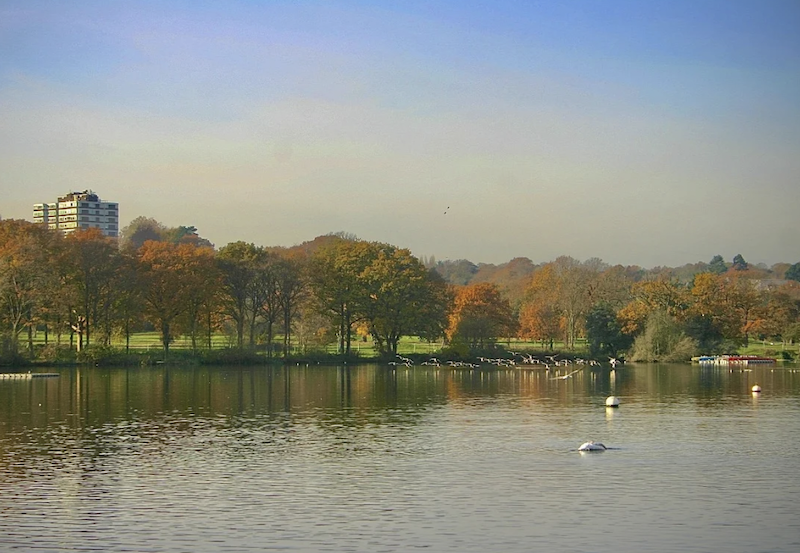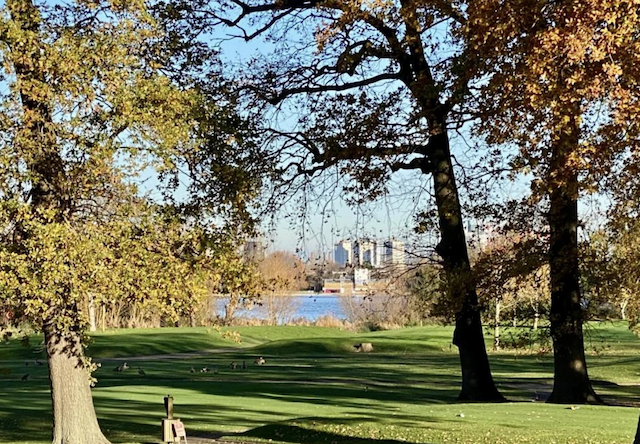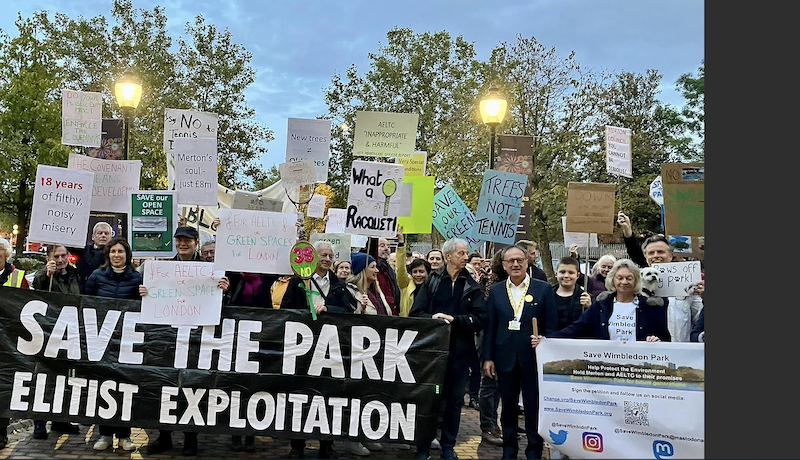Post
What’s happening at Wimbledon Park? Expansion plans under scrutiny
26 May 2024
City Hall will decide on plans to extend the size of the Wimbledon championship’s grounds in July following amendments to the £200m scheme by architects Allies & Morrison.
The scheme was approved by Merton council in October 2023, but quashed by Wandsworth Council due to concerns raised by local groups.
The All England Lawn Tennis Club (AELTC) has put forward proposals to create a new four-acre public parkland to transform the former Wimbledon Park Golf Course. There are applications to build an 8,000-seat stadium, 38 courts, 10 other buildings and 9kms of roads and paths. They propose a new AELTC private park to which the public may be admitted but would also contain a 30,000 square feet maintenance building. (See a map illustrating the plans).
Subscribe to the London Society newsletter
Save Wimbledon Park, a local campaign group, made up of local residents, has voiced concern about these proposals. They say that this would break the 1993 covenants requested by Merton to protect the land, including the golf course, and agreed by AELTC on their purchase.
On 14 July 1993 Merton promised that the golf course would be kept as open space: statement by Tony Colman, leader of Merton Council: “...when we decided to sell this land, we did so ensuring it would be kept as open space and we did so determined that the next owner and any future owner would be denied forever the opportunity to use this space for any development."
Merton Council approved the plans; Wandsworth Council rejected them. The application is now with the GLA. Leonie Cooper, the current GLA representative for Wandsworth and Merton, said: “We need to make sure that the decision taken is the right decision for local people, particularly on the Wandsworth side where the construction phase will blight lives all the way from the Wandsworth one-way system down to the park. It is not a proposal I can support. It will create an industrial wasteland from a Capability Brown landscape and I will continue to speak against it at City Hall to all the right people.”
Wimbledon Park
Landscape architect Capability Brown created the design for Wimbledon Park in 1764/8, and its lake with many of the trees still remaining from that time. Previously much larger, it is now reduced to 60 hectares, with three ownerships: the Council owns the public Park and Lake, the Wimbledon Club is privately owned, and the former Golf Club lands are owned by the All England Lawn Tennis Club, an exclusive private club with around 375 full members
- Formerly 57ha of publicly owned Grade II* Heritage Asset parkland
- Historic England ‘at risk’ register
- Metropolitan Open Land
- Grade I site of Borough Importance for Nature Conservation
- 30ha sold to AELTC in 1993 for £5.2m with legally binding agreements not to develop it
The All England Lawn Tennis Club Proposals
- 8,000-seater concrete stadium (outline only), 28m high, with ancillary facilities & hospitality areas
- 38 grass tennis courts, with concrete edging, artificial drainage, various layers of inorganic material (hard stone, aggregates, coarse sand, topsoil with around 5% organic matter) and fencing to keep out wildlife
- 10 Maintenance and Support buildings of varying sizes as well as ‘underground utilities’
- 9.4km of roads and paths
- Proposal to offset all of the above by giving ‘permissive’ public access to around 9ha of sloping land at the southern end – this includes a large maintenance building, clubhouse, parking lot and paving
Key concerns of Save Wimbledon Park campaigners
- Unacceptable environmental impact. The golf course will be excavated, infilled, and levelled over seven years, threatening protected priority habitats. Claims for biodiversity net gains have been challenged in expert analysis
- 300 mature trees will be felled. An estimated 500+ younger trees will be uprooted
- This is important open space heavily protected in planning policy. Once built upon it could become completely developed
- The 28m high and 104m wide Stadium will dominate the site, contrary to the 1993 covenant
- The new AELTC park will belong to the AELTC. Public access to it and the walk around the lake is “permissive”; it may be withdrawn as their commercial priorities change. The AELTC say their Masterplan for the future of their estate is “an evolving vision”
- A walking route around the lake is welcome and would fulfil a 1993 obligation. The boardwalk over the lake is unacceptable on visual, ecological, and historical grounds
- With tournament use limited to 3 weeks, the density of courts and infrastructure across the site is excessive. Community access to play tennis will be negligible. Championship parking and the Queue will still be on public park land
- The plans assume Church Road will be closed during the Championships, even to pedestrians and cyclists
ALTEC says the proposed northern parkland will be accessible year-round, outside of the Qualifying Competition and The Championships. The northern parkland will include new seating set within grasslands, areas of wildflower meadow, tree and woodland planting.
The tennis association is aware of information circulating in the local community from a variety of sources regarding the AELTC Wimbledon Park Project. The planning application does not include or propose any new development on the public Wimbledon Park, which is owned by Merton Council.
The planning application and development proposals are focused on the AELTC-owned Wimbledon Park Golf Course. However, the planning application also includes works to Wimbledon Park lake and the section of Church Road running between the AELTC Grounds and the golf course.
There are currently more than 50 precious green sites across London threatened with development, according to CPRE London.
These include parks, recreation grounds, open fields, small green spaces in housing estates, sports fields and nature reserves. Many of these sites have protected Green Belt and Metropolitan Open Land status.


